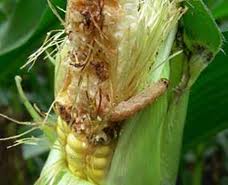Pioneer: Corn Earworm, Western Bean Cutworm Management Tips for
August 15-2013
Corn earworms (CEW) are cannibalistic and normally only one will be found per ear. The pest is best identified by bright, variable color and a cuticle with an “unshaven” look.
It will frequently be near the ear tip but may feed down the ear creating a track of damaged kernels. DuPont Pioneer experts warn the kernel injury creates an ideal environment for ear fungi to invade, leading to a quality problem at harvest.
Trapping and scouting – Light traps or pheromone traps can help determine when adults are flying. Scouting can be done in the field by looking for eggs on the green silks and turning back the silks at the tip of the ear to look for larvae.
Insecticide use – Because the larva is exposed outside the ear for only a short time, economical timing of insecticides is difficult. Stop insecticide application after silks turn brown.
Best management practices – Plant resistant hybrids and alter planting dates to avoid high densities of corn earworms.
Western bean cutworm (WBC) complete one generation of egg, larva, pre-pupa, pupa and adult per year. WBC adults (moths) are strong fliers, and are known to travel several miles. After mating, females deposit their eggs on the top surface of corn leaves in the upper one-third of the plant. Eggs hatch in 5 to 7 days, and larvae feed for 3 to 5 weeks as they develop through five instar stages. In early to mid-September, larvae complete their growth, stop feeding, and drop from the ear to the ground. They then burrow into the soil and construct an earthen cell for overwintering.
Trapping and scouting – Pheromone traps can be used to determine when and where to scout for adult egg laying. As soon as the first moths appear, immediately begin to scouting fields. Look for eggs and larvae on the upper leaf surface in the upper part of the plant. Sample 100 plants by checking 20 consecutive plants in 5 areas of the field, or 10 consecutive plants in 10 areas of the field. In variable fields, or with more hybrids planted, sample more areas of the field.
Insecticide use – When 8 percent of plants have an egg mass or young larva in the tassel, an insecticide application should be considered. This low threshold is necessary because larvae move between plants. Application timing is critical and multiple treatments may be needed.
Best management practices – Plant resistant hybrids to provide in-plant protection against WBC and eliminate the need for intensive scouting.
